Protecting your dog from parasites isn’t the most enjoyable aspect of pet ownership – but it’s a vital part of looking after their health and wellbeing. With the help of Petplan veterinary expert, Brian Faulkner, we look at how to tackle dog fleas, ticks, mites and other common pests.
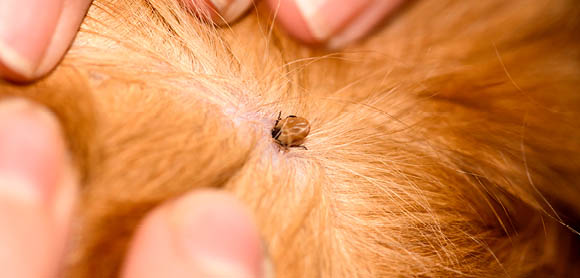
Parasites can make life miserable for our pets, whatever their age. They’re not just irksome – if untreated, they can lead to serious health problems. Fortunately, there are many effective treatments available, and a little knowledge will help keep your dog healthy, happy and pest-free.
What are dog parasites?
Very common and easily transmitted, parasites in dogs cause skin conditions as well as upset stomachs and even heart and lung issues. But with regular checks, your dog can be easily treated if parasites are found.
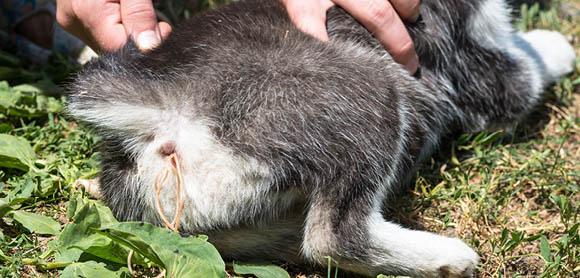
Different types of parasites in dogs
It’s helpful to be aware of the different types of dog parasites, both internal and external, and ways to treat them. Internal parasites, such as worms, are inside the body and can affect organs. While external parasites, such as ticks and fleas, live on the body.
Dog fleas
These small, brown-black parasites love sucking blood and are relatively easy to spot. As well as being uncomfortable for your dog, fleas can lead to serious skin problems if untreated. They can also cause flea allergy dermatitis (FAD) if your dog is allergic to the proteins in flea saliva.
The good news is that these pesky parasites in dogs are easily tackled if found. One way to determine whether your dog has fleas is to groom them with a fine-toothed comb over a moist piece of white kitchen towel. If you see reddish-brown droppings, it’s likely your dog has fleas.
Fleas can be caught from being around other dogs or cats; by someone bringing them into the house on clothes or shoes, or by another infected pet shedding flea eggs on bedding and carpets.
See your vet for advice on the safest and most effective treatment for dog fleas. It’s also important to treat bedding, carpets and soft furnishings in your house and pet bedding thoroughly, to prevent any reinfestation. And don’t forget to make sure any other dogs and cats in your home receive treatment.
Prevention is always better than cure, so use a flea treatment on all your pets regularly to keep them healthy. Consider changing your treatment every few years to ensure parasites don’t get too comfortable with it. While most flea treatments are generally suitable, if your dog is pregnant or a young puppy, it’s worth checking with your vet about the most appropriate action.
Dog lice
If your dog has lice, then they’re likely to have a dry, patchy coat and an insatiable itch. Dog lice are small, but visible to the human eye, as are their tiny white eggs.
There are various types of treatment available from your vet, but if lice have been an issue for a while, your pet might require more than one treatment. The simplest and most effective treatments come in the form of spot-on drops – ask your vet for advice, especially if your dog is still very young. If you have dog insurance with Petplan, you can also access our 24/7 Pet Expert Chat for advice on dog parasites. Just log into your My Petplan account to access.
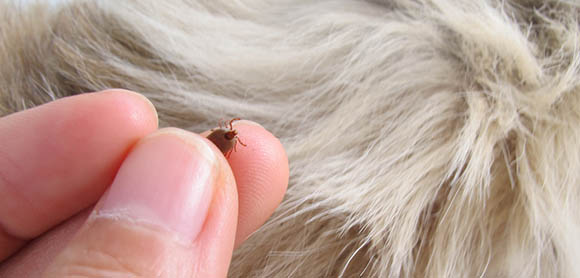
Ticks
Of all the parasites in dogs, ticks can be among the most dastardly. These blood-suckers attach themselves to your dog’s skin, usually in long grass or in woodland. They should be removed immediately to ensure they don’t pass on diseases such as Lyme disease, or cause an abscess.
Dog tick treatment involves removing the parasites with a special tick-removing tool – a twisting motion ensures the head doesn’t remain embedded in your dog’s skin. Again, a preventative spot-on dog tick treatment can be used if you think your pet is likely to be exposed to ticks.
Dog mites
Mites are tiny dog parasites spread by direct skin contact. Dog mites mean your pet is likely to be scratching vigorously and their skin will be scaly, flaking or inflamed.
If you think your dog does have mites, your vet will usually treat them using either a spot-on or oral insecticidal treatment – but you should still also regularly wash bedding and grooming equipment to help prevent the spread.
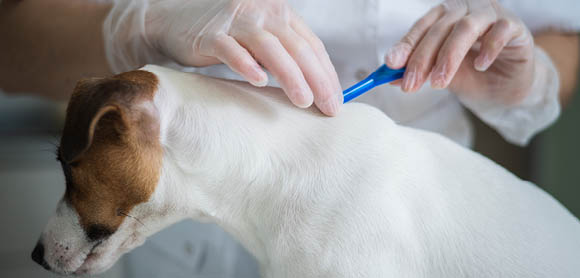
Giardia
This common intestinal parasite can also be passed on to humans. Contracted by drinking contaminated water, faeces or grass, it causes diarrhoea and weight loss.
Dog worms
All dogs are susceptible to worms, regardless of their age, and unfortunately there are a wide range of these internal parasites in dogs to watch out for. Most worms are transmitted when your pet eats worm eggs, but they can also be passed on to puppies from their mother through the milk or placenta.
Common dog worms include:
Roundworms
Found in the gut and lungs, these dog parasites can cause a range of symptoms, including diarrhoea. Roundworm eggs can be found in soil containing the faeces of an infected animal. In rare cases, they can cause sight loss.
Tapeworms
These use intermediate hosts, including fleas and rodents. They absorb pre-digested food inside the bowel and then pass small segments of tapeworm in an infected dog’s droppings. If your pet is rubbing their bottom on the floor or ground, this might be the cause.
Lungworms
These live in the respiratory tract and can affect dogs that eat snails or slugs when chewing grass. Lungworms can be very serious and in extreme cases can lead to death, so seek advice from your vet and make sure you are regularly using preventative products.
Hookworms
These dog parasites literally hook themselves into the lining of the intestines. They can be dangerous as they take vital nutrients from your dog, which can lead to anaemia, and spread to the lungs in more serious cases.

Parasite symptoms
External parasites in dogs are generally easy to spot. Look out for:
- Increased scratching
- Hair loss
- Red or inflamed skin
- Restless behaviour
- Visible fleas
- Debris in your dog’s ears
It can take time before you are aware of symptoms of internal parasites in dogs. These include:
- Worms in faeces
- Respiratory issues
- Loss of appetite
- Distended abdomen
- Diarrhoea
- Vomiting
- Weight loss
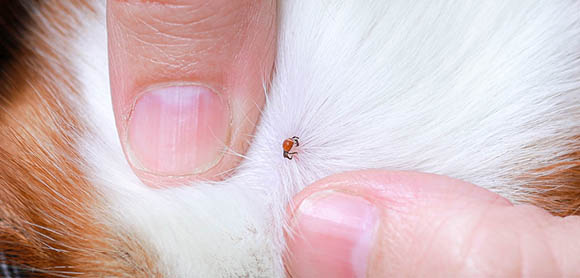
Frequently asked questions
What are the most common dog parasites?
Common internal dog parasites are giardia, tapeworms, hookworms, lungworms and roundworms. Common external parasites in dogs include fleas, lice, ticks and mites.
How serious are internal parasites in dogs?
All parasites affect the health of your dog, but some are more dangerous than others, especially for puppies. As well as causing weight loss and tiredness, parasites can cause long-term damage to the heart and liver.
Can dog parasites be passed on to humans?
Diseases relating to dog worms can pose a risk to humans – particularly children. It’s easy to accidentally contract roundworms by ingesting the parasite’s eggs from soil containing the faeces of an infected animal. In very rare cases, this can cause sight loss.
Keeping your dog free from parasites is important for the whole family. To prevent reinfection, it’s important to dose your dog with an adequate preventative product as frequently as recommended – usually monthly for puppies and then every three months from six months old and upwards. Consult your vet if you need advice on what to use.
Will parasites go away without treatment?
It’s best to speak to your vet about the best form of treatment to kill off parasites and cure any infections. Always clean regularly to reduce any chance of reinfection.
What effective methods have you used to keep your dog clear of parasites? Share your experiences on Petplan’s Facebook page
